Zelda Wii U Demo Details You Might Have Missed
Posted on December 06 2014 by Locke
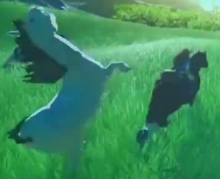 If you’ve already watched the footage ten times and are looking around for analysis and discussion about it, here are some reasons to watch it again.
If you’ve already watched the footage ten times and are looking around for analysis and discussion about it, here are some reasons to watch it again.
First, before the demo begins, it’s important to note that Aonuma is holding the Gamepad, and there is no Wii Remote in sight. Does this mean no motion controls? Who knows, but at the very least, the game is playable with just the Gamepad. I imagine we will also be able to use the Pro Controller. Pikmin 3 boasted several control schemes including using both the Wii Remote Plus and the Gamepad at once, and I hope Zelda Wii U will follow suit.
Turn your attention to the screen and you’ll see the two UI elements. UI usually changes quite a bit all the way up to release, so don’t be surprised to see other elements (such as Rupees) pop up in the future. But for now, many fans will be pleased to see the return of the magic meter! At least, I can only assume it’s a magic meter, as it isn’t utilized at all in the demo. It is green and appears under the hearts as in previous games, and doesn’t appear to be linked with stamina (which the demo notably lacks).
Above this are five hearts, demonstrating that they’re still experimenting with health balance. That assumes this is roughly at the beginning of the game, but most early Skyward Sword demos had six hearts which ended up as the starting number in that game, so it’s a reasonable assumption. Many complained that starting with six hearts in Skyward Sword made it too easy, so fine-tuning this down to five seems like a good move.
Link is mostly the same as his E3 appearance, sans the cape. Will that come into play later, or was it just for show? Perhaps more controversial is the blue tunic. We have yet to see this iteration of Link wearing the iconic green. Is that a convention they’ve rethought? I doubt it. On Link’s back are a sword and a shield as well as a bow and a quiver of arrows. The bow certainly gets the spotlight in this game, perhaps even more than the sword.
 Two other notable features on this first frame (you paused, right?) are the large flag to the right and the lookout tower on the top of the screen. The flag is in the style of those found in the Haunted Wasteland, though this area is far from desert-like. It’s tough to see behind the hill, but just to the left of the large flag are two smaller flags mounted on fence posts, perhaps marking a narrow passage or a bridge. The lookout tower is built in a similar manner as Aryll’s Lookout in The Wind Waker.
Two other notable features on this first frame (you paused, right?) are the large flag to the right and the lookout tower on the top of the screen. The flag is in the style of those found in the Haunted Wasteland, though this area is far from desert-like. It’s tough to see behind the hill, but just to the left of the large flag are two smaller flags mounted on fence posts, perhaps marking a narrow passage or a bridge. The lookout tower is built in a similar manner as Aryll’s Lookout in The Wind Waker.
Unpause now, and watch Link as he climbs the mountain. The running animation changes depending on the slope of the terrain, which really makes it look like he’s working to conquer that hill. It’s very immersive.
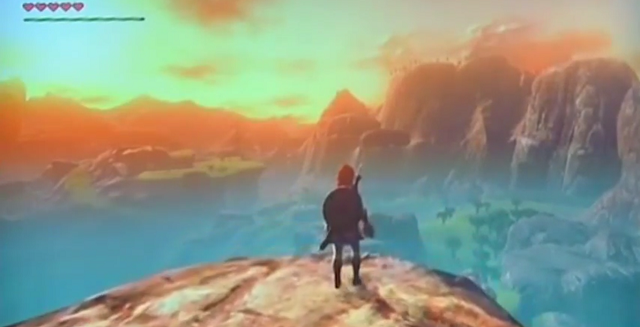
Once Link reaches the precipice, we get a good view of a (small?!?) part of the overworld. Scanning from right to left, we’re first drawn to the large waterfall, which looks great even from this distance. Of course the go-to assumption is that this is Zora’s Waterfall. But there are plenty of other mountains and cliffs for water to fall from, so who knows?
The peak just to the left of the waterfall is spotted with trees, which means it’s likely accessible. Just to the left of that is a lone mountain in the distance which looks an awful lot like a volcano. If the Zora’s Waterfall wasn’t a great assumption, then this being Death Mountain might be a bit better. However, proceeding to the left we see that it’s part of a larger mountain range.
Aonuma then turns the camera downward (note: independent camera control is back!) to show us a valley with some interesting rock formations and a seemingly bottomless pit. In a couple of areas you can see grassy paths spiraling up to the tops of these rock formations. The one on the right supports the kind of rock pile that looks like it needs to be blown up before progressing, but it doesn’t look like it leads anywhere so they’re probably (hopefully) just decoration. This begs an interesting question though: exactly how mobile is Link when it comes to these rock formations? Can he leap from one to the other? Can he climb rock faces? There are a few more interesting rock formations (or is that a giant root?) to the right of the “suspicious” tower before Aonuma goes into the beacon and the map.
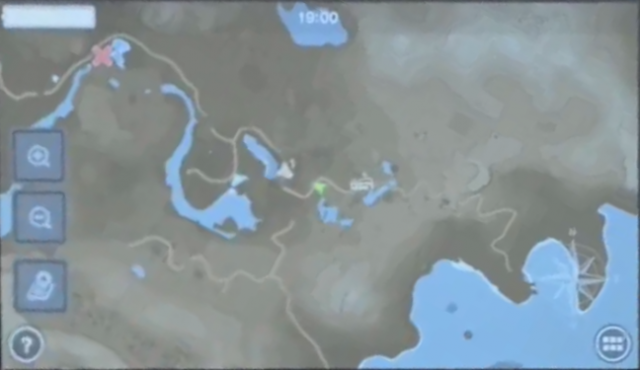
The map. Tons of details here. First, the interface. At the top is what I assume to be a clock. It’s probably real-time, since it doesn’t change in the 20 seconds the map is visible. If you look closely, the clock is on a transparent bar, which also contains the white box in the top-left corner. I have no idea what that box is, but perhaps since it’s within that bar along with the clock, it has something to do with information external to the game, such as Miiverse posts or other notifications.
Along the left side are obviously zoom buttons, and I’d guess the third has something to do with beacons, perhaps a way to set them manually in addition to the automatic one that was shown. The button in the bottom-left is a help button which I assume will work similarly to pressing the 2 button in Skyward Sword. On the right side are a compass and another icon which seems to indicate some sort of inventory. I doubt this is the item inventory, since that would be a step backward from recent advancements in item usability. Instead, it’s probably for quest items or collections, like the bug and material collections in Skyward Sword.
Besides the arrow indicating Link’s position and the X marking the beacon, there are two other marks that you might have missed. Toward the center of the screen, just in front of Link is an oddly-shaped icon. It’s tough to see because it’s the same color as the path and it has that same sort of transparent background as the clock. When Miyamoto reaches over and zooms in, the icon maintains its position relative to the map rather than the screen, but stays constant in size. There’s another icon to the east, though it lacks the dark transparent background. Judging by Link’s position when he meets Epona just a little later in the demo, I’m willing to bet that’s what the first icon represents.
Looking at the map itself, the topographical features are a nice touch, especially with how varied the elevations are. This detail extends even to the water. Shallow shores are marked in white, and deep pockets are shown in dark blue. (Could there be some significance to the one by the small island in the bay southeast of Link’s position?) You’ll also notice that what looked from above like a bottomless pit actually contains a small lake and appears to be accessible. There are a few other features east of Link’s position such as a bridge. (Maybe the one he fights the monster on in the E3 trailer?)
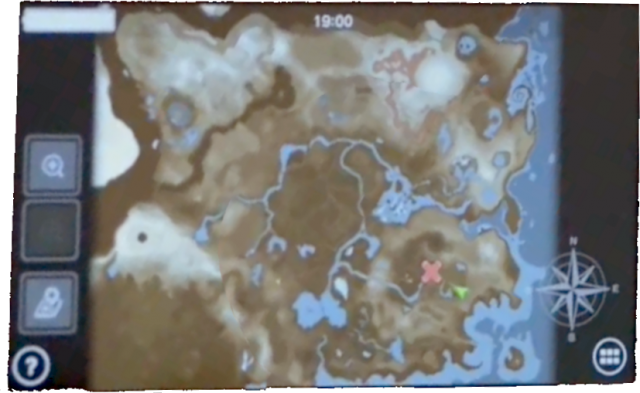
When the map is fully zoomed out, those two icons disappear, but we can get a good view of some of the major features of this game’s overworld. We’ll start with what we saw from the panorama. We can now see that what we thought was Zora’s Waterfall is actually just a tiny speck of blue. The real Zora’s Waterfall and Zora’s Domain is likely behind that to the north, halfway toward Death Mountain. The Death Mountain theory is further supported by the reddish area in its vicinity which appears to indicate lava flow. (I wonder if they intended the lake (hot spring?) just northeast of “Death” Mountain to look like a skull?) The larger mountain range can be seen to the west of Death Mountain, behind which is what looks to be Gerudo Desert. There’s even an oasis in the desert.
There are two major candidates for Lake Hylia – I think it’s the southwest one in the bottom-center of the map, the northeast one corresponding to Hyrule Castle. These landmarks all line up with geography established in previous games, with Zora’s River starting from the waterfall in Zora’s Domain, flowing past Hyrule Castle (or through it, or around it, like in A Link to the Past), and feeding Lake Hylia. Death Mountain is in the northeast, and Gerudo Desert in the northwest. Through induction, this would imply that the area we’re being shown corresponds to Kokiri Forest, which is typically Link’s starting location.
Jumping off the cliff, we see the familiar Sailcloth from Skyward Sword. However, it functions more like the Deku Leaf from The Wind Waker, except that it doesn’t drain the magic meter. When Aonuma encounters Epona, he gives us a good view of the valley below where he just was. You can see the tower to the right and the lake below, which is enough to triangulate his position to being exactly where the icon mentioned earlier was. So that icon apparently tracks Epona’s location on the map.
Cut to Link riding Epona, and he’s suddenly wearing that hood we saw at E3. Maybe it’s just like how Mario got his hat: they couldn’t animate his hair. Kidding. Just look at how the grass is pushed aside as Epona runs through it.
In case you haven’t yet gotten over this beautiful grassy landscape or the fact that Epona won’t run into trees, please consider that come this time next year you’ll probably be playing the game yourself, and look at the controls. Aonuma is nudging the left analog stick left and right to steer, and pressing A to go faster (accompanied by Link shouting). In addition to the A button, the HUD also explains that you can tap down on the left analog stick to brake. Unfortunately I can’t make out what’s written by the R button. The right analog stick moves the camera. Y (possibly B – hard to tell) swings the sword, and ZR fires arrows – press to aim, release to fire.
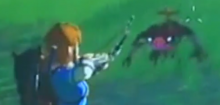 When Link pulls out his bow, an arrow indicator appears on the HUD. It includes a picture of the arrow, the quantity (max 100), and an indication that using the D-Pad will do something – I assume switch arrow types.
When Link pulls out his bow, an arrow indicator appears on the HUD. It includes a picture of the arrow, the quantity (max 100), and an indication that using the D-Pad will do something – I assume switch arrow types.
The enemies we see here appear to be a combination of Bokoblin and Moblin designs from The Wind Waker. They act like Bokoblins, but they have the pig’s snout of Moblins. But besides enemies, there are also neutral animals to be found in the fields. As Aonuma and Miyamoto tease Majora’s Mask (yet again), Link rides around and discovers several other creatures. The first can be seen atop a large rock and appears to be some sort of ram. Rounding the rock, there are four horses which run alongside Epona (who carelessly collides with one, so much for not running into things). Finally, there’s a brown animal which I assume to be a type of deer back in the trees (as Epona awkwardly sidesteps around some rocks).
Miyamoto’s closing remark put into words what I was feeling the whole time watching Aonuma ride around on Epona. It’s so accessible – that is, efficient and free of unnecessary hindrances – that you don’t have to spend your full attention on it. In this case, the extra attention was spent on conversation. But when playing alone, Aonuma noted the ability to use weapons and move the camera. I think you’ll find that moving the camera is something you’re going to want to do all the time while riding, to take in this vast and enticing world, and you’ll be glad Epona can avoid trees by herself.



